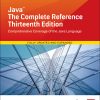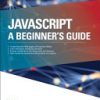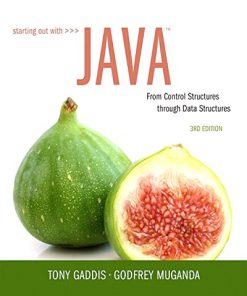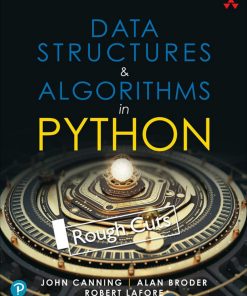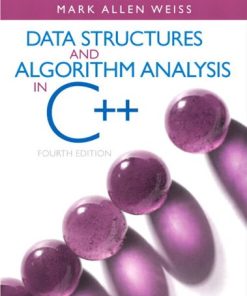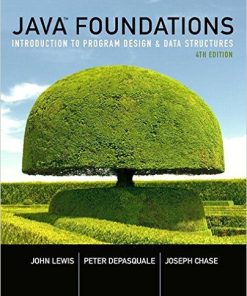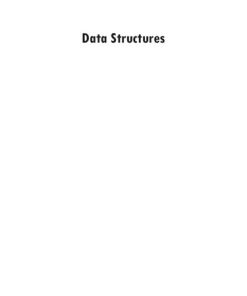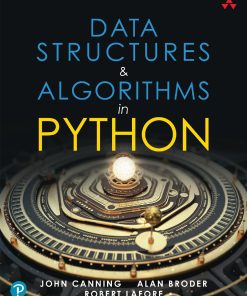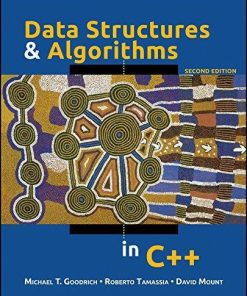(Ebook PDF) Data structures and algorithm analysis in Java 3rd Edition by Mark Allen Weiss 0133465012 9780133465013 full chapters
$50.00 Original price was: $50.00.$25.00Current price is: $25.00.
Data structures and algorithm analysis in Java 3rd Edition by Mark Allen Weiss – Ebook PDF Instant Download/DeliveryISBN: 0133465012, 9780133465013
Full download Data structures and algorithm analysis in Java 3rd Edition after payment.
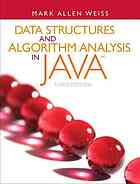
Product details:
ISBN-10 : 0133465012
ISBN-13 : 9780133465013
Author: Mark Allen Weiss
This is the eBook of the printed book and may not include any media, website access codes, or print supplements that may come packaged with the bound book. Data Structures and Algorithm Analysis in Java is an “advanced algorithms” book that fits between traditional CS2 and Algorithms Analysis courses. In the old ACM Curriculum Guidelines, this course was known as CS7. This text is for readers who want to learn good programming and algorithm analysis skills simultaneously so that they can develop such programs with the maximum amount of efficiency. Readers should have some knowledge of intermediate programming, including topics as object-based programming and recursion, and some background in discrete math. As the speed and power of computers increases, so does the need for effective programming and algorithm analysis. By approaching these skills in tandem, Mark Allen Weiss teaches readers to develop well-constructed, maximally efficient programs in Java. Weiss clearly explains topics from binary heaps to sorting to NP-completeness, and dedicates a full chapter to amortized analysis and advanced data structures and their implementation. Figures and examples illustrating successive stages of algorithms contribute to Weiss’ careful, rigorous and in-depth analysis of each type of algorithm. A logical organization of topics and full access to source code complement the text’s coverage.
Data structures and algorithm analysis in Java 3rd Table of contents:
Chapter 1 Introduction
1.1 What’s the Book About?
1.2 Mathematics Review
1.2.1 Exponents
1.2.2 Logarithms
1.2.3 Series
1.2.4 Modular Arithmetic
1.2.5 The P Word
Proof by Induction
Proof by Counterexample
Proof by Contradiction
1.3 A Brief Introduction to Recursion
Printing Out Numbers
Recursion and Induction
1.4 Implementing Generic Components Pre-Java 5
1.4.1 Using Object for Genericity
1.4.2 Wrappers for Primitive Types
1.4.3 Using Interface Types for Genericity
1.4.4 Compatibility of Array Types
1.5 Implementing Generic Components Using Java 5 Generics
1.5.1 Simple Generic Classes and Interfaces
1.5.2 Autoboxing/Unboxing
1.5.3 The Diamond Operator
1.5.4 Wildcards with Bounds
1.5.5 Generic Static Methods
1.5.6 Type Bounds
1.5.7 Type Erasure
1.5.8 Restrictions on Generics
Primitive Types
instanceof tests
Static Contexts
Instantiation of Generic Types
Generic Array Objects
Arrays of Parameterized Types
1.6 Function Objects
Summary
Exercises
References
Chapter 2 Algorithm Analysis
2.1 Mathematical Background
2.2 Model
2.3 What to Analyze
2.4 Running Time Calculations
2.4.1 A Simple Example
2.4.2 General Rules
2.4.3 Solutions for the Maximum Subsequence Sum Problem
2.4.4 Logarithms in the Running Time
Binary Search
Euclid’s Algorithm
Exponentiation
2.4.5 A Grain of Salt
Summary
Exercises
References
Chapter 3 Lists, Stacks, and Queues
3.1 Abstract Data Types (ADTs)
3.2 The List ADT
3.2.1 Simple Array Implementation of Lists
3.2.2 Simple Linked Lists
3.3 Lists in the Java Collections API
3.3.1 Collection Interface
3.3.2 Iterator s
3.3.3 The List Interface, ArrayList, and LinkedList
3.3.4 Example: Using remove on a LinkedList
3.3.5 ListIterators
3.4 Implementation of ArrayList
3.4.1 The Basic Class
3.4.2 The Iterator and Java Nested and Inner Classes
3.5 Implementation of LinkedList
3.6 The Stack ADT
3.6.1 Stack Model
3.6.2 Implementation of Stacks
Linked List Implementation of Stacks
Array Implementation of Stacks
3.6.3 Applications
Balancing Symbols
Postfix Expressions
Infix to Postfix Conversion
Method Calls
3.7 The Queue ADT
3.7.1 Queue Model
3.7.2 Array Implementation of Queues
3.7.3 Applications of Queues
Summary
Exercises
Chapter 4 Trees
4.1 Preliminaries
4.1.1 Implementation of Trees
4.1.2 Tree Traversals with an Application
4.2 Binary Trees
4.2.1 Implementation
4.2.2 An Example: Expression Trees
Constructing an Expression Tree
4.3 The Search Tree ADT—Binary Search Trees
4.3.1 contains
4.3.2 findMin and findMax
4.3.3 insert
4.3.4 remove
4.3.5 Average-Case Analysis
4.4 AVL Trees
4.4.1 Single Rotation
4.4.2 Double Rotation
4.5 Splay Trees
4.5.1 A Simple Idea (That Does Not Work)
4.5.2 Splaying
4.6 Tree Traversals (Revisited)
4.7 B-Trees
4.8 Sets and Maps in the Standard Library
4.8.1 Sets
4.8.2 Maps
4.8.3 Implementation of TreeSet and TreeMap
4.8.4 An Example That Uses Several Maps
Summary
Exercises
References
Chapter 5 Hashing
5.1 General Idea
5.2 Hash Function
5.3 Separate Chaining
5.4 Hash Tables Without Linked Lists
5.4.1 Linear Probing
5.4.2 Quadratic Probing
5.4.3 Double Hashing
5.5 Rehashing
5.6 Hash Tables in the Standard Library
5.7 Hash Tables with Worst-Case O(1) Access
5.7.1 Perfect Hashing
5.7.2 Cuckoo Hashing
Cuckoo Hash Table Implementation
5.7.3 Hopscotch Hashing
5.8 Universal Hashing
5.9 Extendible Hashing
Summary
Exercises
References
Chapter 6 Priority Queues (Heaps)
6.1 Model
6.2 Simple Implementations
6.3 Binary Heap
6.3.1 Structure Property
6.3.2 Heap-Order Property
6.3.3 Basic Heap Operations
insert
deleteMin
6.3.4 Other Heap Operations
decreaseKey
increaseKey
delete
buildHeap
6.4 Applications of Priority Queues
6.4.1 The Selection Problem
Algorithm 6A
Algorithm 6B
6.4.2 Event Simulation
6.5 d-Heaps
6.6 Leftist Heaps
6.6.1 Leftist Heap Property
6.6.2 Leftist Heap Operations
6.7 Skew Heaps
6.8 Binomial Queues
6.8.1 Binomial Queue Structure
6.8.2 Binomial Queue Operations
6.8.3 Implementation of Binomial Queues
6.9 Priority Queues in the Standard Library
Summary
Exercises
References
Chapter 7 Sorting
7.1 Preliminaries
7.2 Insertion Sort
7.2.1 The Algorithm
7.2.2 Analysis of Insertion Sort
7.3 A Lower Bound for Simple Sorting Algorithms
7.4 Shellsort
7.4.1 Worst-Case Analysis of Shellsort
7.5 Heapsort
7.5.1 Analysis of Heapsort
7.6 Mergesort
7.6.1 Analysis of Mergesort
7.7 Quicksort
7.7.1 Picking the Pivot
A Wrong Way
A Safe Maneuver
Median-of-Three Partitioning
7.7.2 Partitioning Strategy
7.7.3 Small Arrays
7.7.4 Actual Quicksort Routines
7.7.5 Analysis of Quicksort
Worst-Case Analysis
Best-Case Analysis
Average-Case Analysis
7.7.6 A Linear-Expected-Time Algorithm for Selection
7.8 A General Lower Bound for Sorting
7.8.1 Decision Trees
7.9 Decision-Tree Lower Bounds for Selection Problems
7.10 Adversary Lower Bounds
Lower Bound for Finding the Minimum and Maximum
7.11 Linear-Time Sorts: Bucket Sort and Radix Sort
7.12 External Sorting
7.12.1 Why We Need New Algorithms
7.12.2 Model for External Sorting
7.12.3 The Simple Algorithm
7.12.4 Multiway Merge
7.12.5 Polyphase Merge
7.12.6 Replacement Selection
Summary
Exercises
References
Chapter 8 The Disjoint Set Class
8.1 Equivalence Relations
8.2 The Dynamic Equivalence Problem
8.3 Basic Data Structure
8.4 Smart Union Algorithms
8.5 Path Compression
8.6 Worst Case for Union-by-Rank and Path Compression
8.6.1 Slowly Growing Functions
8.6.2 An Analysis By Recursive Decomposition
Partial Path Compression
A Recursive Decomposition
8.6.3 An O( M log * N ) Bound
8.6.4 An O( M α(M, N) ) Bound
8.7 An Application
Summary
Exercises
References
Chapter 9 Graph Algorithms
9.1 Definitions
9.1.1 Representation of Graphs
9.2 Topological Sort
9.3 Shortest-Path Algorithms
9.3.1 Unweighted Shortest Paths
9.3.2 Dijkstra’s Algorithm
9.3.3 Graphs with Negative Edge Costs
9.3.4 Acyclic Graphs
9.3.5 All-Pairs Shortest Path
9.3.6 Shortest-Path Example
9.4 Network Flow Problems
9.4.1 A Simple Maximum-Flow Algorithm
9.5 Minimum Spanning Tree
9.5.1 Prim’s Algorithm
9.5.2 Kruskal’s Algorithm
9.6 Applications of Depth-First Search
9.6.1 Undirected Graphs
9.6.2 Biconnectivity
9.6.3 Euler Circuits
9.6.4 Directed Graphs
9.6.5 Finding Strong Components
9.7 Introduction to NP-Completeness
9.7.1 Easy vs. Hard
9.7.2 The Class NP
9.7.3 NP-Complete Problems
Summary
Exercises
References
Chapter 10 Algorithm Design Techniques
10.1 Greedy Algorithms
10.1.1 A Simple Scheduling Problem
The Multiprocessor Case
Minimizing the Final Completion Time
10.1.2 Huffman Codes
Huffman’s Algorithm
10.1.3 Approximate Bin Packing
Online Algorithms
Next Fit
First Fit
Best Fit
Off-line Algorithms
10.2 Divide and Conquer
10.2.1 Running Time of Divide-and-Conquer Algorithms
10.2.2 Closest-Points Problem
10.2.3 The Selection Problem
Reducing the Average Number of Comparisons
10.2.4 Theoretical Improvements for Arithmetic Problems
Multiplying Integers
Matrix Multiplication
10.3 Dynamic Programming
10.3.1 Using a Table Instead of Recursion
10.3.2 Ordering Matrix Multiplications
10.3.3 Optimal Binary Search Tree
10.3.4 All-Pairs Shortest Path
10.4 Randomized Algorithms
10.4.1 Random Number Generators
10.4.2 Skip Lists
10.4.3 Primality Testing
10.5 Backtracking Algorithms
10.5.1 The Turnpike Reconstruction Problem
10.5.2 Games
Minimax Strategy
α-β Pruning
Summary
Exercises
References
Chapter 11 Amortized Analysis
11.1 An Unrelated Puzzle
11.2 Binomial Queues
11.3 Skew Heaps
11.4 Fibonacci Heaps
11.4.1 Cutting Nodes in Leftist Heaps
11.4.2 Lazy Merging for Binomial Queues
Amortized Analysis of Lazy Binomial Queues
11.4.3 The Fibonacci Heap Operations
11.4.4 Proof of the Time Bound
11.5 Splay Trees
Summary
Exercises
References
Chapter 12 Advanced Data Structures and Implementation
12.1 Top-Down Splay Trees
12.2 Red-Black Trees
12.2.1 Bottom-Up Insertion
12.2.2 Top-Down Red-Black Trees
12.2.3 Top-Down Deletion
12.3 Treaps
12.4 Suffix Arrays and Suffix Trees
12.4.1 Suffix Arrays
12.4.2 Suffix Trees
12.4.3 Linear-Time Construction of Suffix Arrays and Suffix Trees
12.5 k-d Trees
12.6 Pairing Heaps
People also search for Data structures and algorithm analysis in Java 3rd:
data structures and algorithm analysis in c 2nd edition pdf
data structures and algorithm analysis in ada mark allen weiss
data structures and algorithm analysis mark allen weiss pdf
data structures and algorithm analysis clifford a shaffer
data structures and algorithm analysis in c++ answers
Tags:
Data structures,algorithm,analysis,Java,Mark Allen Weiss
You may also like…
Uncategorized
Starting Out with Java: From Control Structures through Data Structures 3rd Edition, (Ebook PDF)
Computers - Algorithms and Data Structures
Business & Economics - Personal Finance
Volume III: Data Storage, Data Processing and Data Analysis 1st 2021 Edition Volker Liermann
Uncategorized
Computers - Algorithms and Data Structures
Computers - Algorithms and Data Structures
Uncategorized


